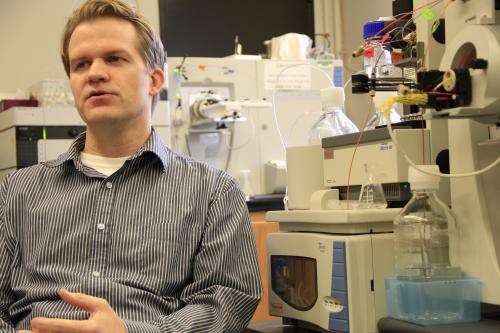Baffling blood problem explained: 60-year-old health mystery solved

In the early 1950's, a 66-year-old woman, sick with colon cancer, received a blood transfusion. Then, unexpectedly, she suffered a severe rejection of the transfused blood. Reporting on her case, the French medical journal Revue D'Hématologie identified her as, simply, "Patient Vel."
After a previous transfusion, it turns out, Mrs. Vel had developed a potent antibody against some unknown molecule found on the red blood cells of most people in the world—but not found on her own red blood cells.
But what was this molecule? Nobody could find it. A blood mystery began, and, from her case, a new blood type, "Vel-negative," was described in 1952.
Soon it was discovered that Mrs. Vel was not alone. Though rare, it is estimated now that over 200,000 people in Europe and a similar number in North America are Vel-negative, about 1 in 2,500.
For these people, successive blood transfusions could easily turn to kidney failure and death. So, for sixty years, doctors and researchers have hunted—unsuccessfully—for the underlying cause of this blood type.
But now a team of scientists from the University of Vermont and France has found the missing molecule—a tiny protein called SMIM1—and the mystery is solved.
Reporting in the journal EMBO Molecular Medicine, UVM's Bryan Ballif, Lionel Arnaud of the French National Institute of Blood Transfusion, and their colleagues explain how they uncovered the biochemical and genetic basis of Vel-negative blood.
"Our findings promise to provide immediate assistance to health-care professionals should they encounter this rare but vexing blood type," says Ballif.
The pre-publication results were presented online, March 18, 2013, and the finalized report will be published, as an open-access article, in the next edition of the journal.
(Last year, Ballif and Arnaud identified the proteins responsible for two other rare blood types, Junior and Langeris, moving the global count of understood blood types or systems from 30 to 32. Now, with Vel, the number rises to 33.)
Before this new research, the only way to determine if someone was Vel-negative or positive was with tests using antibodies made by the few people previously identified as Vel-negative following their rejection of transfused blood. Not surprisingly, these antibodies are vanishingly rare and, therefore, many hospitals and blood banks don't have the capacity to test for this blood type.
"Vel– blood is one of the most difficult blood types to supply in many countries," the scientists write, "This is partly due to the rarity of the Vel− blood type, but also to the lack of systematic screening for the Vel−type in blood donors."
In response, the UVM and Paris researchers developed two fast DNA-based tests for identifying Vel-negative blood and people. These tests can be easily integrated into existing blood testing procedures—and can be completed in a few hours or less.
"It's usually a crisis when you need a transfusion" says Ballif. "For those rare Vel-negative individuals in need of a blood transfusion, this is a potentially life-saving time frame."
To make their discovery, Arnaud and coworkers in Paris used some of the rare Vel-negative antibody to biochemically purify the mystery protein from the surface of human red blood cells. Then they shipped them to Ballif in Vermont.
The little protein didn't reveal its identity easily. "I had to fish through thousands of proteins," Ballif says. And several experiments failed to find the culprit because of its unusual biochemistry—and pipsqueak size. But he eventually nabbed it using a high-resolution mass spectrometer funded by the Vermont Genetics Network. And what he found was new to science. "It was only a predicted protein based on the human genome," says Ballif, but hadn't yet been observed. It has since been named: Small Integral Membrane Protein 1, or SMIM1.
Next, Arnaud's team in France tested seventy people known to be Vel-negative. In every case, they found a deletion—a tiny missing chunk of DNA—in the gene that instructs cells on how to manufacture SMIM1. This was the final proof the scientists needed to show that the Vel-negative blood type is caused by a lack of the SMIM1 protein on a patient's red blood cells.
Today, personalized medicine— where doctors treat us based on our unique biological makeup—is a hot trend. "The science of blood transfusion has been attempting personalized medicine since its inception," Ballif notes, "given that its goal is to personalize a transfusion by making the best match possible between donor and recipient."
"Identifying and making available rare blood types such as Vel-negative blood brings us closer to a goal of personalized medicine," he says. "Even if you are that rare one person out of 2,500 that is Vel-negative, we now know how to rapidly type your blood and find blood for you—should you need a transfusion."

















